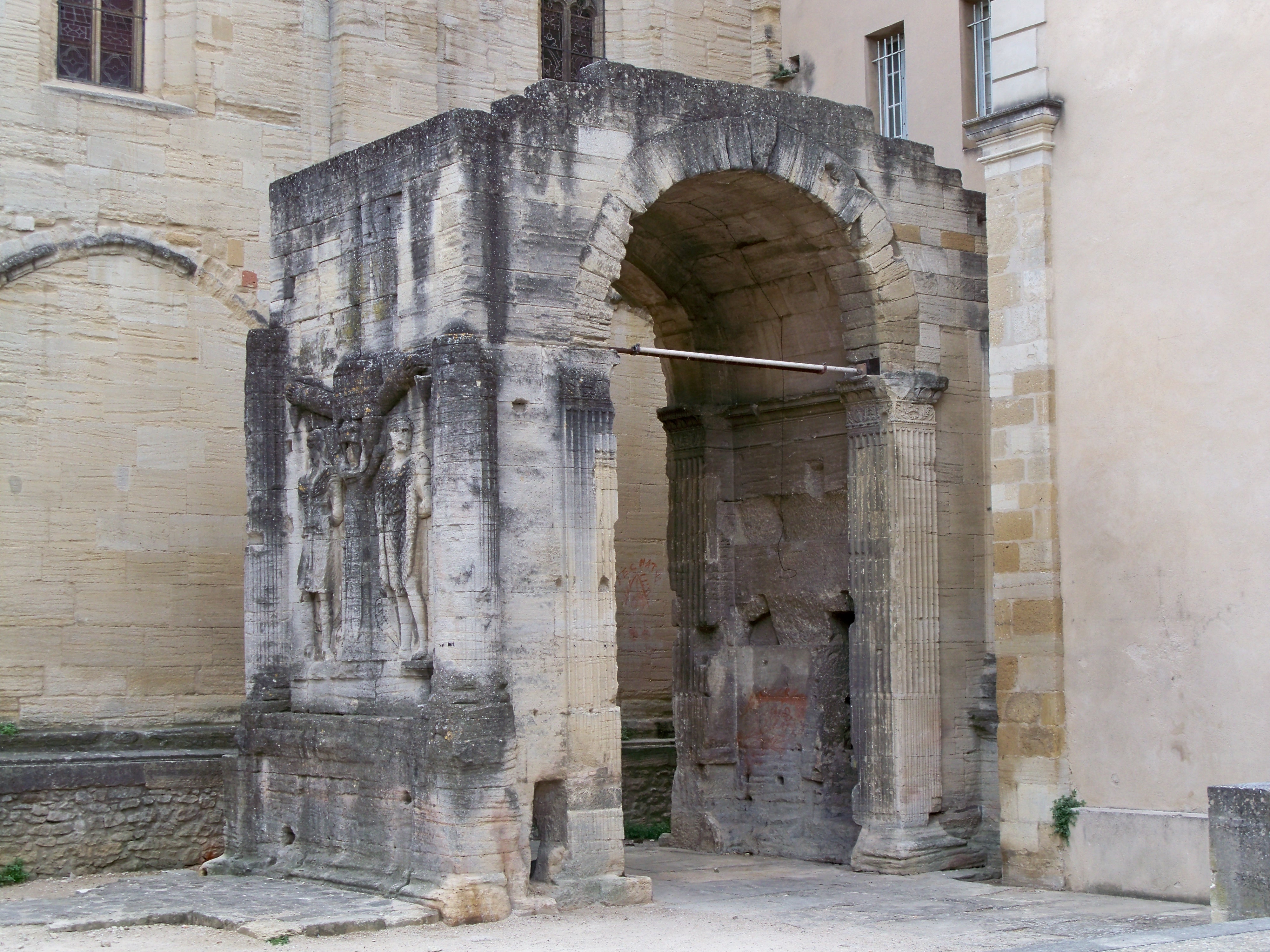Arch Of Carpentras on:
[Wikipedia]
[Google]
[Amazon]
 The Arch of Carpentras is a
The Arch of Carpentras is a
Roman
Roman or Romans most often refers to:
*Rome, the capital city of Italy
*Ancient Rome, Roman civilization from 8th century BC to 5th century AD
* Roman people, the people of ancient Rome
*'' Epistle to the Romans'', shortened to ''Romans'', a lett ...
triumphal arch
A triumphal arch is a free-standing monumental structure in the shape of an archway with one or more arched passageways, often designed to span a road. In its simplest form a triumphal arch consists of two massive piers connected by an arch, crow ...
from the beginning of the first century AD, located at Carpentras
Carpentras (, formerly ; Provençal Occitan: ''Carpentràs'' in classical norm or ''Carpentras'' in Mistralian norm; la, Carpentoracte) is a commune in the Vaucluse department in the Provence-Alpes-Côte d'Azur region in southeastern France.
...
in the French
French (french: français(e), link=no) may refer to:
* Something of, from, or related to France
** French language, which originated in France, and its various dialects and accents
** French people, a nation and ethnic group identified with Franc ...
department of Vaucluse
Vaucluse (; oc, Vauclusa, label=Provençal or ) is a department in the southeastern French region of Provence-Alpes-Côte d'Azur. It had a population of 561,469 as of 2019.fluted
Fluting may refer to:
* Fluting (architecture)
* Fluting (firearms)
*Fluting (geology)
* Fluting (glacial)
*Fluting (paper)
Arts, entertainment, and media
*Fluting on the Hump
See also
*Flute (disambiguation)
A flute is a musical instrument.
...
lesenes and decorated with an archivolt
An archivolt (or voussure) is an ornamental moulding or band following the curve on the underside of an arch.
It is composed of bands of ornamental mouldings (or other architectural elements) surrounding an arched opening, corresponding to the ...
of vine tendrils. At the outer corners there are engaged columns. On the sides there are images of trophies flanked by barbarian prisoners. These trophy reliefs are also found on the short sides of the Arch of Orange, which is however more richly decorated.
The arch was originally located on the city's '' cardo maximus''. Later it was incorporated into the old cathedral as an access door and still later into the episcopal palace (now the courthouse).
The arch was included in the first list of French historic monuments in 1840.
Interpretation
Various theories have been proposed for the motivation for its construction. The theories are essentially based on the interpretation of the barbarian prisoners on the two reliefs (on the west side aGerman
German(s) may refer to:
* Germany (of or related to)
**Germania (historical use)
* Germans, citizens of Germany, people of German ancestry, or native speakers of the German language
** For citizens of Germany, see also German nationality law
**Ger ...
and an eastern barbarian with a Phrygia
In classical antiquity, Phrygia ( ; grc, Φρυγία, ''Phrygía'' ) was a kingdom in the west central part of Anatolia, in what is now Asian Turkey, centered on the Sangarios River. After its conquest, it became a region of the great empire ...
n beard, another eastern barbarian and a person with a diadem
A diadem is a type of Crown (headgear), crown, specifically an ornamental headband worn by monarchs and others as a badge of royalty.
Overview
The word derives from the Ancient Greek, Greek διάδημα ''diádēma'', "band" or "fillet", fr ...
which might indicate a Hellenistic
In Classical antiquity, the Hellenistic period covers the time in Mediterranean history after Classical Greece, between the death of Alexander the Great in 323 BC and the emergence of the Roman Empire, as signified by the Battle of Actium i ...
king on the east side).
*Gilbert Picard has proposed that the arch was built to symbolically commemorate the victory of Augustus
Caesar Augustus (born Gaius Octavius; 23 September 63 BC – 19 August AD 14), also known as Octavian, was the first Roman emperor; he reigned from 27 BC until his death in AD 14. He is known for being the founder of the Roman Pr ...
in the eastern and northern regions. Pierre Gros
Pierre Gros (born May 7, 1939 in Incheville, France) is a contemporary scholar of ancient Roman architecture and the Latin language, particularly the texts of the writer Vitruvius.
He presently holds the post of Professor of Latin language and ...
also proposed a date before 10 AD on the basis of the decorative motifs and a reference to the theme of Augustus' universal victory in the face of the succession issue of the last years of this Emperor's reign.
*R. Turcan has instead suggested that it was a celebration of the victories of Tiberius
Tiberius Julius Caesar Augustus (; 16 November 42 BC – 16 March AD 37) was the second Roman emperor. He reigned from AD 14 until 37, succeeding his stepfather, the first Roman emperor Augustus. Tiberius was born in Rome in 42 BC. His father ...
in the east and west in the years 18–19, perhaps related to the foundation of the colonia ''Julia Meminorum'' at Carpentras.R. Turcan, "L'arc de Carpentras: problèmes de datation et d'histoire", in ''Hommages à L. Lerat'', Besançon-Parigi 1984, pp. 810-819.
See also
*List of Roman triumphal arches
This is a list of Roman triumphal arches. Triumphal arches were constructed across the Roman Empire and are an archetypal example of Roman architecture. Most surviving Roman arches date from the Imperial period (1st century BC onwards). They were ...
Notes
External links
* {{coord, 44.0544, N, 5.0475, E, source:wikidata, display=title Triumphal arches in France